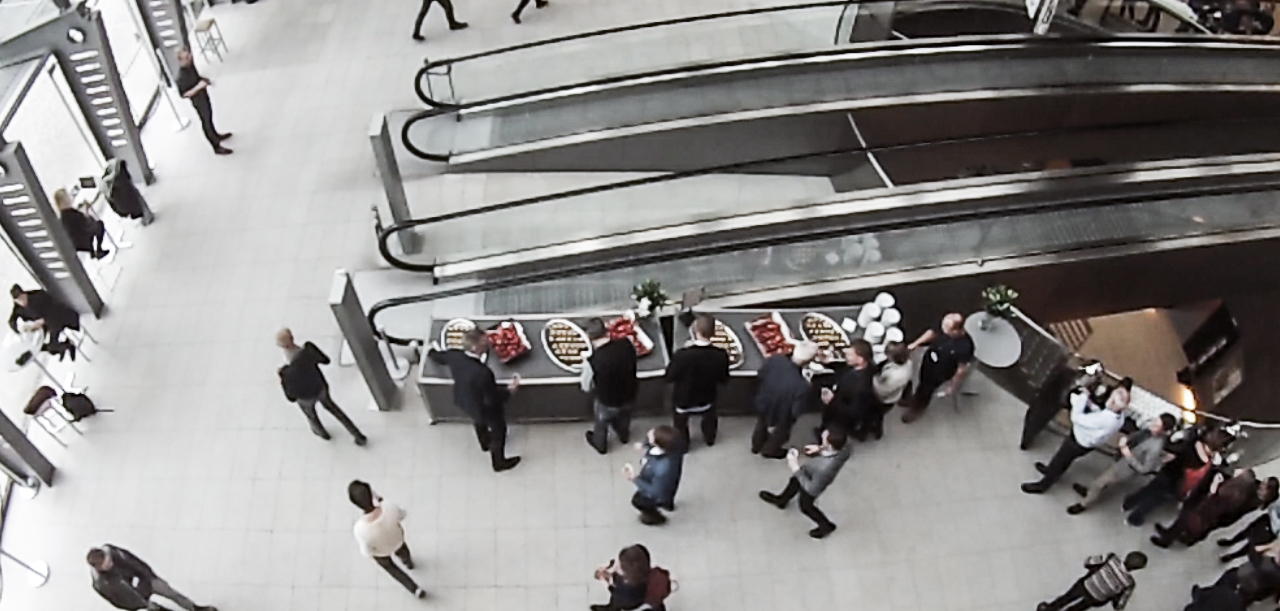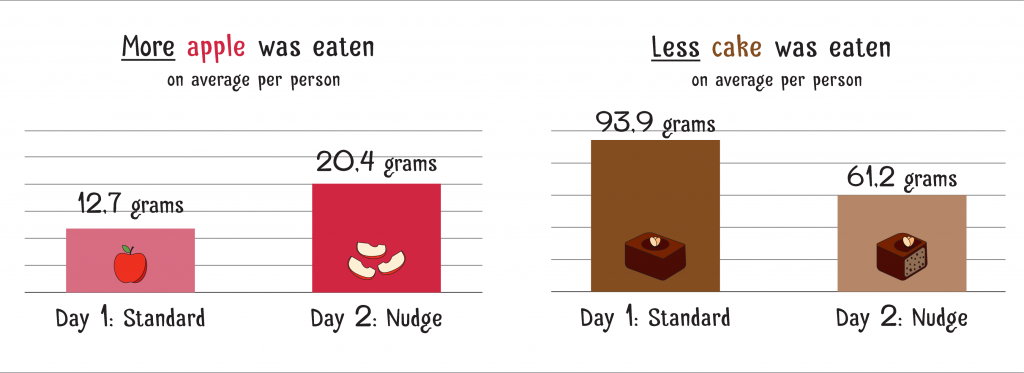
Do you decide what you eat yourself? By using one simple trick we changed a classic buffet break. The result: more people ate more apples; less people ate a whole piece of cake.
Many of us are struggling to stay on the narrow path of healthy choices. At work, at meetings, and in the car on the way home we are constantly tempted to snack a little bit – to kill boredom, to have a good time, or to get some quick energy to stay awake and aware. Each single occurrence does obviously not make a difference, but over time one snack becomes more, and slowly but surely our waistline expands.
Watch the video from our experiment
At iNudgeyou we have made several experiments to see if simple nudges can change how much we eat. This time we teamed up with the restaurant Søren K and got close to the participants at a big conference for Danish communicators in the Royal Library. We wanted to try out a simple trick – and as a bonus we caught the Editor in chief at Weekendavisen, Martin Krasnik, and the politician, Holger K. Nielsen, with their fingers in the proverbial cookie jar.
Fact Box: Nudge
The Experiment
A number of behavioural experiments indicate that very small changes in surroundings can nudge how much we end up eating. Research has looked into everything from plate size to the width and height of glasses, and even if it is better to use spoons instead of tongs in the salad bar [2]. This time we experimented with a contextual factor that is consistent for all foodscapes: the size of the units the food is served in.
Fact Box: Unit Bias

Smaller Pieces Work
The results from the experiment showed that the small change in size lead to a significant change in the conference participants’ intake of apples and cake. The average intake of apples per person increased from 12.7 grams to 20.4 grams – this corresponds to people eating 60.8 % more apple when it was served in smaller pieces than when served as whole apples. The opposite pattern appeared for the intake of cake; that fell from 93.9 grams to 61.2 grams in average per person. Thus, 34.8 % less cake was eaten when the pieces were cut in half.

Besides this result, which replicate one of our earlier experiments [5], our method of measuring gave us the possibility to measure something that has not previously been accounted for; namely how the intake is distributed among each individual. And this is where it gets really interesting: with the whole apple, only 32,9 % of the participants ate some apple; whereas when the apples were cut in smaller pieces, 85,3 % of the conference participants ate apple. We also saw a decrease in the share of conference participants who ate cake; namely 83.5 % on Day 1 and 74.7 % on Day 2, when the cake was cut in smaller pieces.
What Can We Learn From This Experiment?
This experiment teaches us a number of things. For unit bias to work, the food portions should be within a reasonable size range. In other words, that means when we are presented with a whole baking pan of cake, the portion size is too big for us to eat it all. On the other hand, a cake crumb would be too small for us, and we would most probably eat more crumbs to be satisfied. Somewhere in between those two extremes there will be a number of different cake sizes that we accept as a suitable portion.

If a food portion, as with the breadcrumbs, is not big enough to make the unit bias come into force, people will take more units. This is exactly the case when we cut the apples in smaller pieces. The apple pieces were small enough that the conference participants chose to take more pieces on their plate. Another insight stemming from this experiment is the importance of the principle of convenience.
Fact Box: Principle of Convenience

A Simple Trick Can Nudge You To Eat Healthier
Ultimately, the experiment confirms the general point that similar experiments working with unit bias and the principle of convenience have indicated:
Serve healthy food easily and conveniently in suitable portion sizes.
In that way we can, to a large extent, facilitate far more appropriate food intake than we ourselves are able to handle, when left alone to take into account all aspects of the complex contexts on the narrow path of healthy choices.
References
- [1] Hansen, P.G. (2016). The Definition of Nudge and Libertarian Paternalism: Does The Hand fit the Glove? European Journal of Risk Regulation.
- [2] Hansen, P.G., Skov, K.L., Skov, L.R. (2016). Making Healthy Choices Easier: Regulation vs. Nudging. The Annual Review of Public Health, Vol. 37, March 17.
- [3] Geier, A. B., Rozin, P., & Doros, G. (2006). Unit bias: A new heuristic that helps explain the effect of portion size on food intake. Psychological Science, 17(6), 521-525.
- [4] Wansink, Brian (2007). “Portion Size Me: Downsizing our consumption norms”. Journal of the American dietetic association. 20 (10): 1–4.
- [5] Hansen, P.G.; Skov, KL; Skov, LR; Jespersen, AM; Schmidt, K (2015) Apples vs. Brownies : A Field Experiment in Rearranging Conference Snacking Buffets to Reduce Short-Term Energy. Journal of Foodservice Business Research, Vol. 19, Nr. 1, 2015.
